Workflow apps help project managers plan their processes and manage tasks, but, arguably, its most important feature is automation.
Workflow automation helps remove mundane, repetitive tasks from the workload while enabling teams to focus on high-impact tasks instead.
It’s no wonder then that teams across different niches are keen to adopt automation software.
Take marketing, for example. A 2019 report projected annual growth of over 30% for the US marketing automation software industry.
If you are among the many PMs that want to boost project management via a workflow app, this article is the perfect place to start.
We’ve highlighted what a workflow application does, how you can use one to create a workflow effortlessly, and how monday.com can help create the ideal workflow.
What is a workflow app?
Workflow management software is a combination of tools designed to help managers identify, create, and edit the steps involved in a workflow or process.
Project tasks and everyday business activities can all move through standard process flows.
“Assign – In Progress – Completed” is a simple example of a Kanban workflow.
With a workflow app, project managers can standardize workflows across multiple projects and track progress efficiently. All project information and process data can also be stored and updated on a single platform.This eliminates the need for a constant back and forth between team members for every task.
Many project management tools have workflow-related features and automation included in them. monday.com, for example, allows you to automate low-impact, repetitive tasks across your workflows and remove manual steps such as sending notifications and reminders.
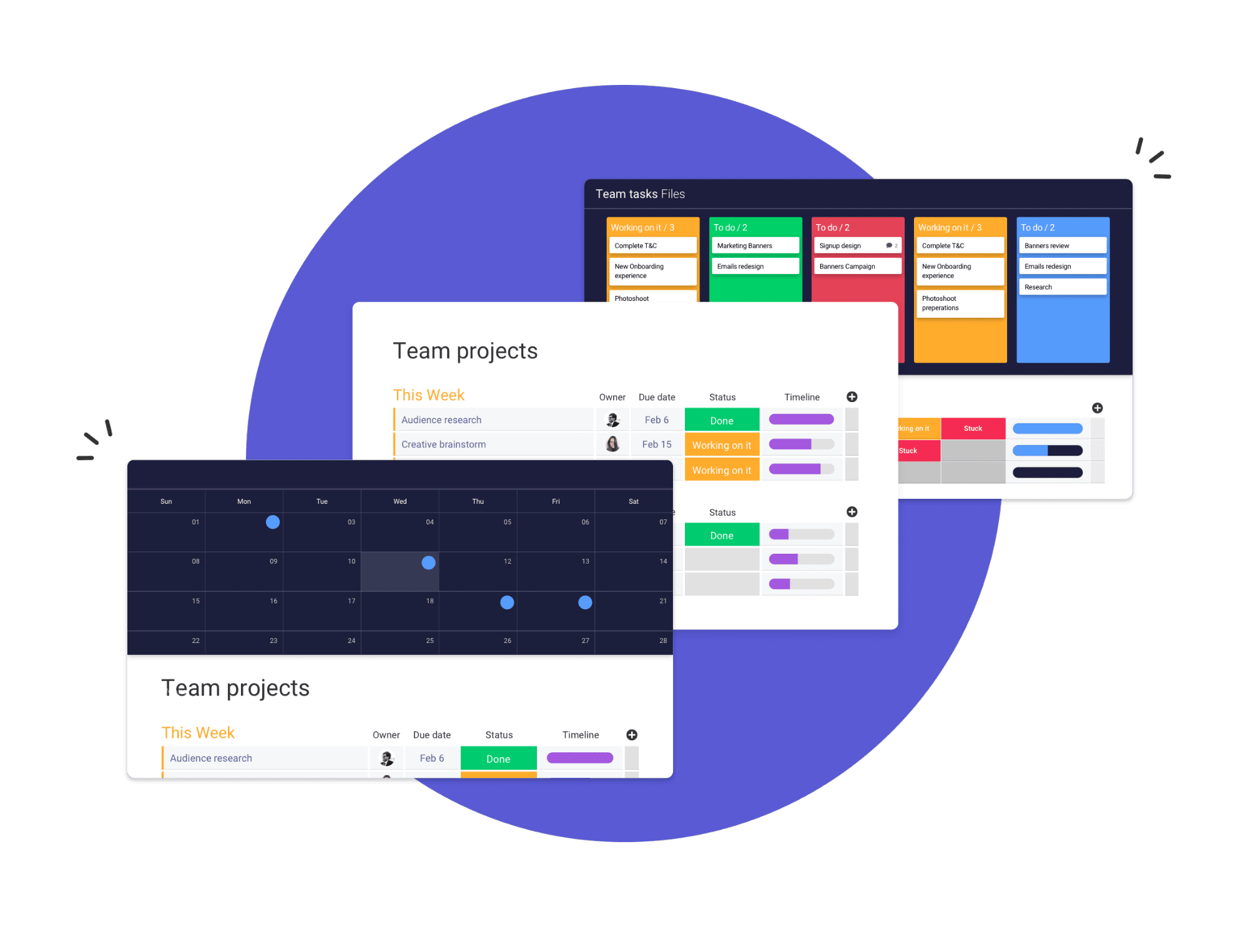
How do you create a workflow?
Any manager can create an efficient project workflow online, using the following steps:
- Identify resources: take note of your resources. Determine the budget, the number of team members, any new hires or extra funding needed, etc.
Another important aspect of taking stock is understanding and analyzing your existing workflows for the resources they used and seeing where changes are needed.
For example, you can understand the financial aspect of your current project better by reaching out to the finance team and see how they handled the process for previous projects.
- Identify the tasks: list all the tasks in the process or project and determine how to perform them. This helps define your work process.
You can determine if your tasks are conditional and depend on the previous tasks or if they need to be completed in parallel. This assessment will then determine the methodology you follow, how tasks are scheduled, assigned, and completed.
- Identify critical players: look at the team members and decide key players. These people could be team leads or managers or just employees who’ve performed exceptionally in previous projects.
Assign vital task(s) to these individuals and provide them all the information and resources they need to complete it.
Key players could be anyone you trust to move tasks along the workflow efficiently. It could be an editor or a senior member that reviews and approves tasks.
- Define critical factors: critical factors are those that control the fate of the project. Apart from critical players, task and project deadlines, standard work processes, guidelines, etc., are all vital factors.
- Decide milestones: milestones are specific points in a project timeline that are used to determine progress. Start and end dates are considered milestones, but you could also set milestones on dates where you’d like reviews or budget checks.
High priority tasks or deliverables that directly impact project duration and outcome are also milestones.
For example, a milestone could be to deliver X assets by X date. Meeting this milestone implies your project is on track while missing it is cause for re-evaluation.
- Set a workflow: with all the information you’ve gathered so far, you can set up all the steps in your workflow.
Determine how tasks in a project will move from beginning to end. Your workflow is a step-by-step process.
Start with the basic steps and make it as complex as needed. A basic writing workflow might have 4 steps – assign articles, writing in progress, editing, and delivery.
Whether you’re a rookie or a pro, or if you’re planning a straightforward project or a complex one, you can use workflow apps like monday.com to create a workflow using templates. The platform also provides advanced features to perfect the workflow with ease.
- Choose the right software: going off of the last point, the software you choose has a major impact on your project.
The right software can smoothen the process of creating and implementing a workflow across all niches, but the wrong one can have teams chasing their own tails.
Choosing a flexible platform also makes it easy to edit your workflow. On monday.com, for example, you can quickly re-schedule your tasks by clicking on the dates and selecting new ones or dragging and dropping them on the timeline.
- Visualize your workflow: the final step of the workflow, before you implement it, is to visualize it. Seeing your entire workflow represented as a timeline, Gantt chart, or on a Kanban board helps you understand if it’s really the right one for your team to complete the project.
A visual representation of the workflow also helps identify bottlenecks and any other potential issues.
Have you planned too many tasks at the same time? Are your milestones realistic? Is work divided fairly among team members? – PMs can consider all of these questions before putting their plan into action.
- Testing: implement your workflow and closely monitor it. If the work process works in the initial stages, you can let it be or optimize it further based on your observations.
- Tweaks: if you notice bottlenecks or issues, then address them by adjusting the workflow until your process is streamlined.
7 reasons why monday.com is the perfect workflow app
monday.com is a comprehensive Work OS that lets you build and implement project workflows effortlessly, regardless of the niche. Here’s how:
#1. Project templates
PMs that have to manage multiple projects don’t have the time to spend hours building project boards.
Whether you’re a rookie or a pro, you can set up a project board with your own workflow in minutes on monday.com, thanks to the platform’s 100+ templates that match every niche.
The templates have pre-made workflows, so you can either get started immediately by adding tasks or customize the workflow first and then add other project details.
Even if you choose to start from scratch and not use a template, monday.com makes it super convenient to implement your complex workflows.
#2. Visualized workflow
On monday.com, PMs and teams can visualize their project workflows using the platform’s 9 board views.
Your workflow doesn’t have to be a list of grouped tasks. It can be a timeline that shows all your tasks in chronological order or a Gantt chart that is perfect for the Waterfall project management methodology.
Arguably the best method to visualize repeatable project workflows is the Kanban view. This view can also be used for Scrum boards for sprints.
If you want to focus on the essentials, you can use the Files view to see all the files uploaded on the board.
You can also use Workloads, Calendars, Forms, and Maps.
A visual overview of the workflow helps PMs plan better and identify potential issues once the workflow is implemented. It also increases transparency among team members because they have a clear direction to head towards.
#3. Automation
Automation is a necessity in project management. It significantly improves workflows since it allows teams to focus on impactful work rather than mundane, repetitive tasks. Automating a manual process saves time.
monday.com eliminates low-impact tasks out of the workload using automation rules or recipes. These recipes are predefined combinations of actions and triggers.
So when event A (trigger) occurs, then you can automate the consequent action that takes place. Here’s an example:
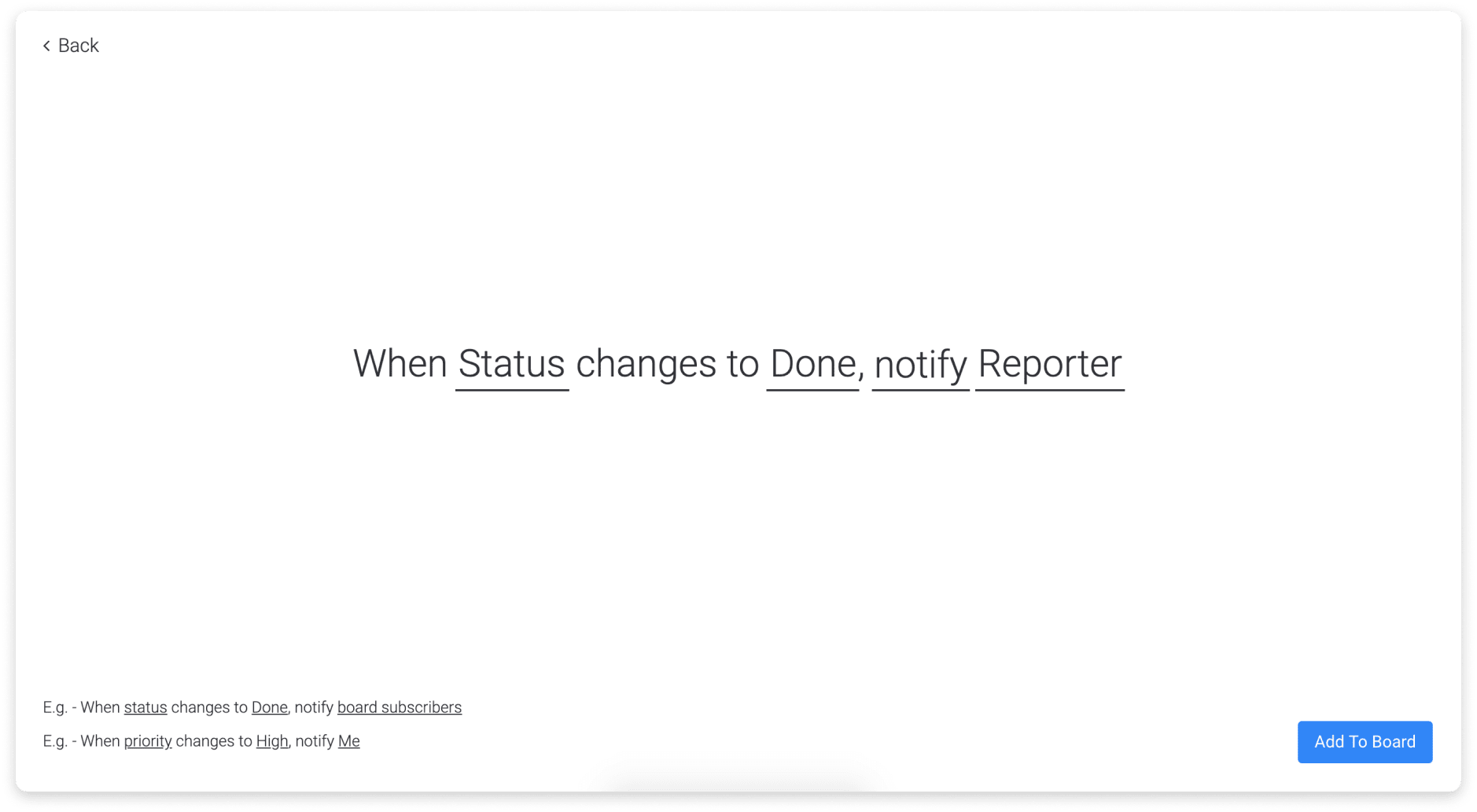
With an automated workflow on monday.com, repetitive tasks are automatically created, and you can dictate how certain tasks move through the workflow. You can also set time-based automation and a lot more.
#4. Budget and resource management
Your project workflow is dependent on the budget you have to work with and the resources at hand.
But once a project starts, how do you keep track of budget limits or resources? Enter Dashboards.
monday.com’s Dashboard is a space where you can add 20+ types of visual widgets. PMs can track anything they want – numbers, deadlines, progress, workloads, etc.
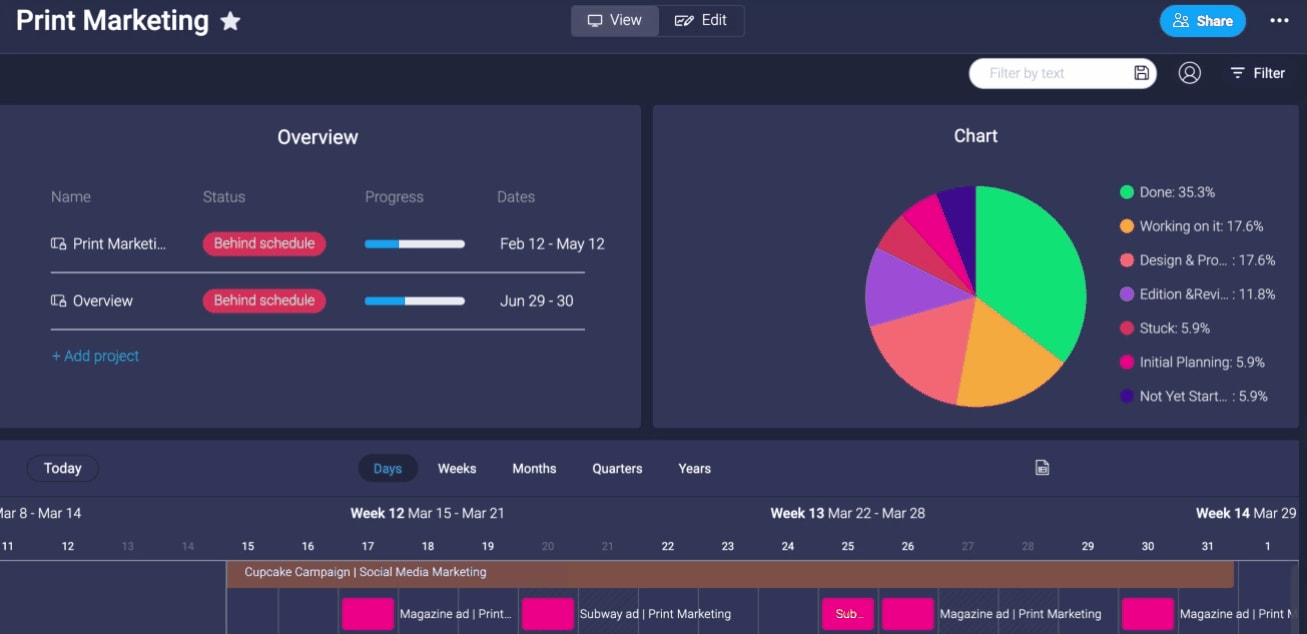
Workflow management is incomplete without analysis. PMs need to assess workflows to ensure everyone is on track and the team is moving towards on-time project completion.
The Dashboard and monday.com’s different project views all help PMs identify workflow issues beforehand. So, they can make changes to address the problems before they impact the project.
#5. Customization
Your project should be customizable on every level so that your team can complete it smoothly.
For example, tasks need to contain every relevant detail, so your team members don’t have to go looking for files or reach out to you to confirm basic elements.
On monday.com, you can add descriptions, titles, checklists, comments, images, files, and so much more. Each task can be assigned to multiple team members. This promotes efficient task management.
PMs can customize workflows with ease as well. They can move every element around to adapt to any changing circumstances during a project.
For example, on a Kanban board, you can drag and drop task cards from one column to another. You can also move columns around to make changes to work processes.
Another example would be the Timeline view, where task dates can be changed by an user by extending or shortening the relevant cell or just clicking on it and altering the dates.

#6. Collaboration
Collaboration is essential in the modern workplace.
Your team needs to be a well-oiled machine. One of the biggest hurdles that teams face is poor communication, where team members have to have multiple messages and emails to clear task details or make simple changes.
We’ve already explained how monday.com lets you add all the task details in one place.
To add to this, monday.com allows in-task comments. Users can streamline communication by adding comments directly to a task. So, everyone involved in the conversation knows all the details.
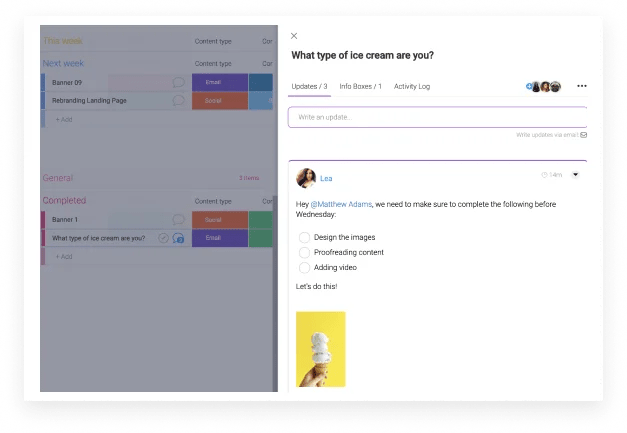
Team members can also attach files directly to a task, rather than using a different platform.
Every project also has a Discussion board for broader project-related discussions or general chatter.
Team members can also access monday docs, an electronic document space where anyone brainstorm, sync, and collaborate across teams. Because the building block is the only connected workdoc, you and your teams can turn thoughts and notes into actionable, organized workflows.
#7. Integration
The more apps a platform can integrate with, the lesser tools you have to juggle. Workflows are also streamlined because of added functionality.
monday.com integrates with hundreds of third-party apps, including social media tools, CRMs, software development platforms, and more.
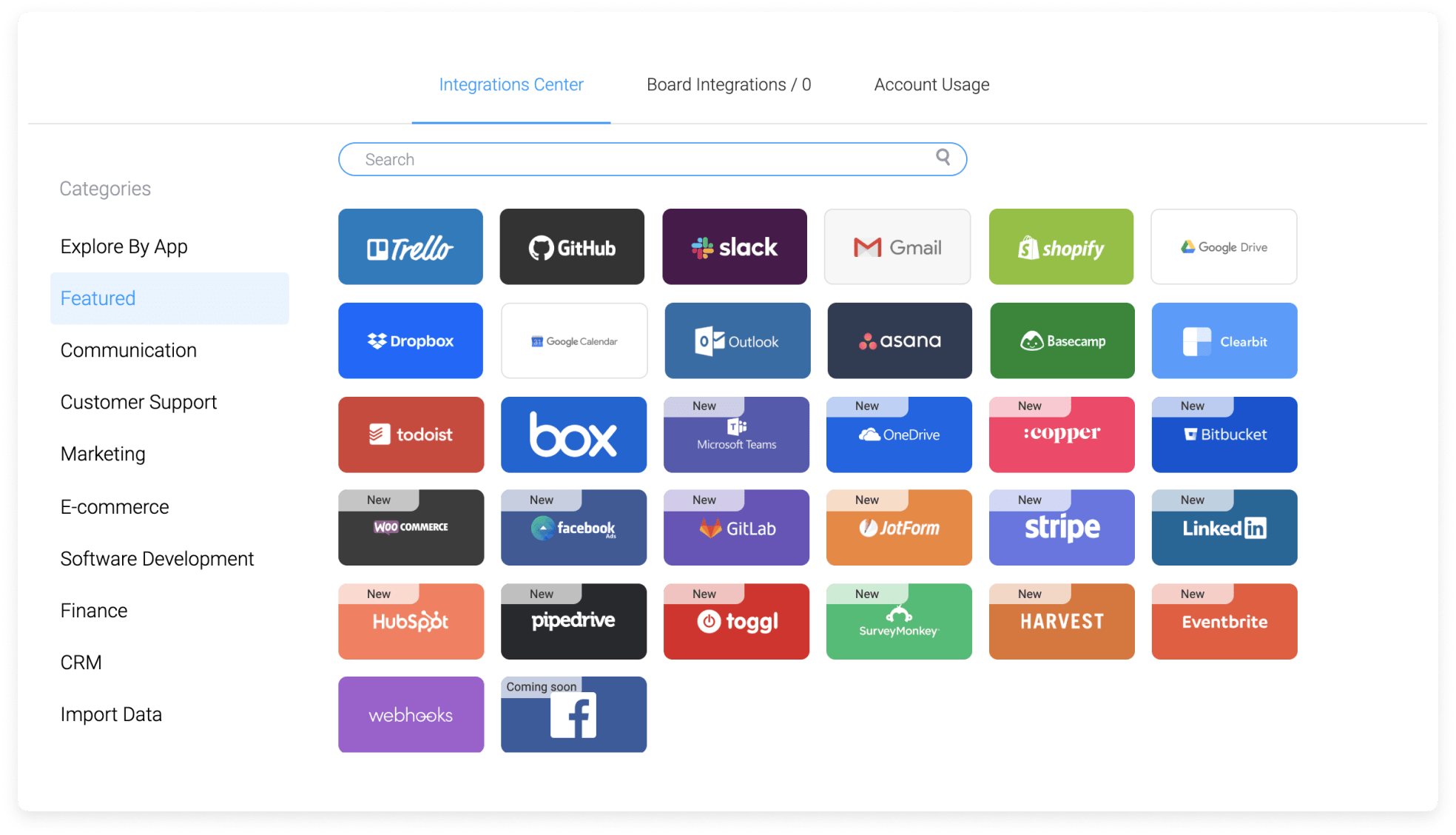
With monday.com’s integrations, you can leave the juggling to the clowns and focus on your work instead.
Wrapping up
A workflow app makes creating, editing and keeping track of project workflows a breeze.
A true Work OS like monday.com takes workflow management one step further.
It allows users to set custom visual workflows for every project, work with multiple views, automate work processes, and track progress all in one place.
Whether you’re working on a marketing campaign or employee onboarding,
This promotes transparency between PMs and team members, improves communication and collaboration, and ultimately boosts productivity.
You can get started with monday.com by using the project planning template to help you map out your project workflows.

